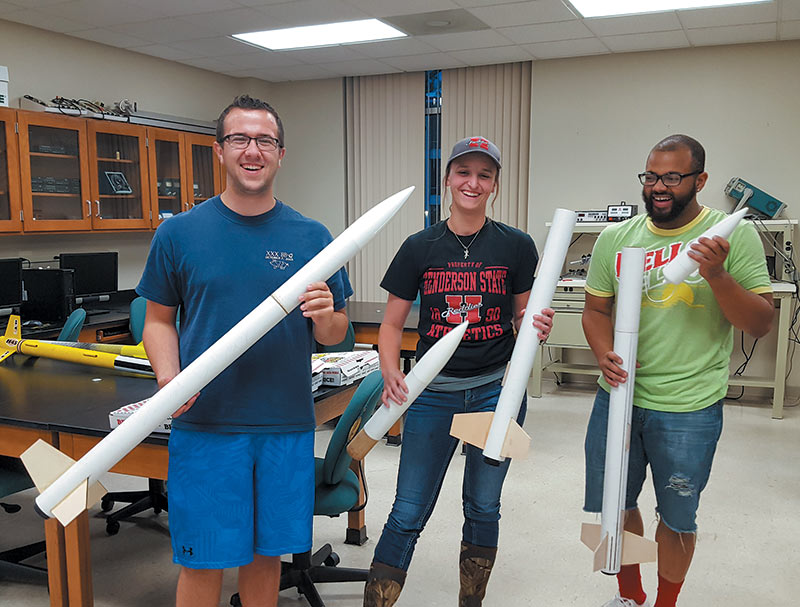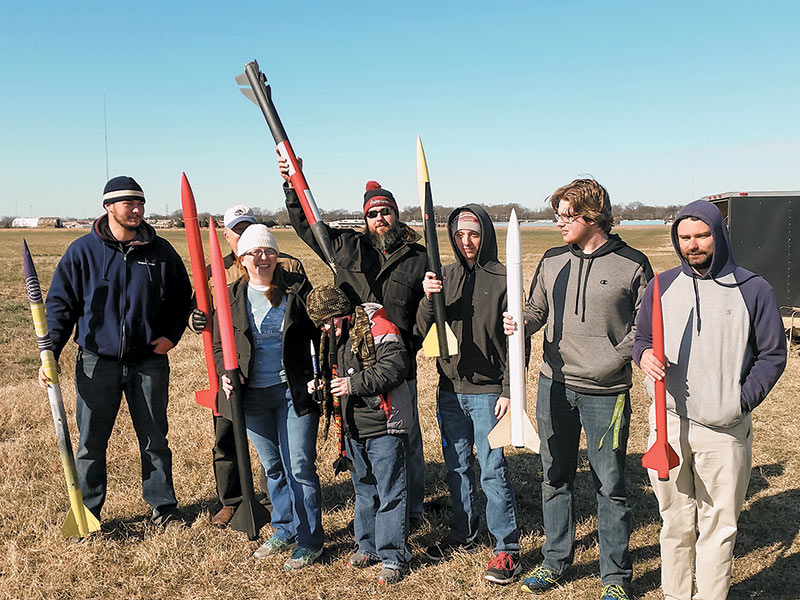Building a High-Powered Rocketry Program
Fall
2019
Building Blocks - Undergraduate Research and Outreach Projects
Building a High-Powered Rocketry Program
Shannon Clardy, Professor of Physics, Henderson State University
 After deciding to add an engineering major to our physics department, we knew we needed collaborative projects that would utilize the skill sets of both majors to help us get our research off the ground (pun intended). In search of something exciting, unique, and encompassing both engineering and physics, we landed on high-powered rocketry.
After deciding to add an engineering major to our physics department, we knew we needed collaborative projects that would utilize the skill sets of both majors to help us get our research off the ground (pun intended). In search of something exciting, unique, and encompassing both engineering and physics, we landed on high-powered rocketry.
If you like model rockets, you will love high-powered rocketry. It is literally a blast! To get started, a colleague and I became members of the National Association of Rocketry (NAR). Along with Tripoli Rocketry Association, the NAR upholds standards and best practices to ensure safety in sport-rocketry. Both are nonprofit scientific organizations dedicated to space-modeling. After becoming members, we started Reddie Rockets, NAR section no. 777—the first rocketry section in Arkansas. The NAR makes the process easy and provides a significant insurance benefit for approved launch sites.
Rocket motors aren’t classified by the altitude obtained in flight but rather by the impulse and total thrust provided to the rocket. Typically, A–D motors are available at the hobby store, but high-power certification is required to fly rockets with motors I–O, which have over 160 Newton-seconds (N s) of impulse. This means that if it fires for 1.5 seconds, it applies 160/1.5 = 106.6 Newtons of force each second it is firing. There are federal regulations controlling how these motors are stored, shipped, purchased, and used—you must be a member of either NAR or Tripoli to even purchase them, and you need an FAA waiver for launch airspace.
There are three levels of certification in high-powered rocketry.
Level-1 certification involves building, flying, and recovering a rocket with an H- or I-level motor. An I motor has up to 640 N s of impulse; for comparison, a C motor has 10 N s. The rocket cannot sustain significant damage and must be able to fly again. In order to verify a launch for certification, two NAR members with that level of certification or higher must be present.
To earn their level-1 certifications, our students build the Loc Precision Hi-Tech H45 rocket, a less-expensive, sturdy rocket. The rocket comes in a kit, but we make a few modifications, such as adding an Aero Pack motor retainer to hold the motor in the rocket and threading the recovery harness through the motor mounts. The recovery harness keeps the body and the nose cone of the rocket tied together when the parachute pops out. When the parachute is blown out of the rocket, it causes a significant deceleration in the rate of falling, and if the recovery harness isn’t attached well, the rocket may come down in separate pieces. Students fly this rocket on H125–H152 motors and generally achieve an altitude of around 3,500 feet.
Level-2 rocketry certification is similar to level-1 certification but involves higher impulse motors (J and K motors, up to 2,560 N s of impulse) and a written exam covering safety and regulations. Level-3 motors include L–O motors, which can have up to 40,960 N s of impulse. For certification at this level, the flyer must incorporate redundant electronic parachute deployment systems rather than using a delay grain and a charge. Significant documentation is required for this level of certification, and we are currently working toward our qualification by flying rockets with electronic parachute deployment.
One of the benefits of developing a high-powered rocketry program is the wealth of possible research topics. Our students have studied mechanisms for using altimeters to deploy parachutes, developed tracking devices, designed camera and electronics mounting systems, considered the effects of weight and balance on rocket trajectory, simulated thrust and impulse in programs like RockSim and OpenRocket, and analyzed forces on different shapes of airfoils. In addition, the program stimulates fellowship, fun, and outreach. Students have the opportunity to participate in national rocketry competitions, and we work with community groups of various sizes for workshops, public model-rocket launches, and camps. Rocketry is captivating for all ages, as it will propel us into the future of space exploration.

More from this department
Building Blocks - Undergraduate Research and Outreach Projects
